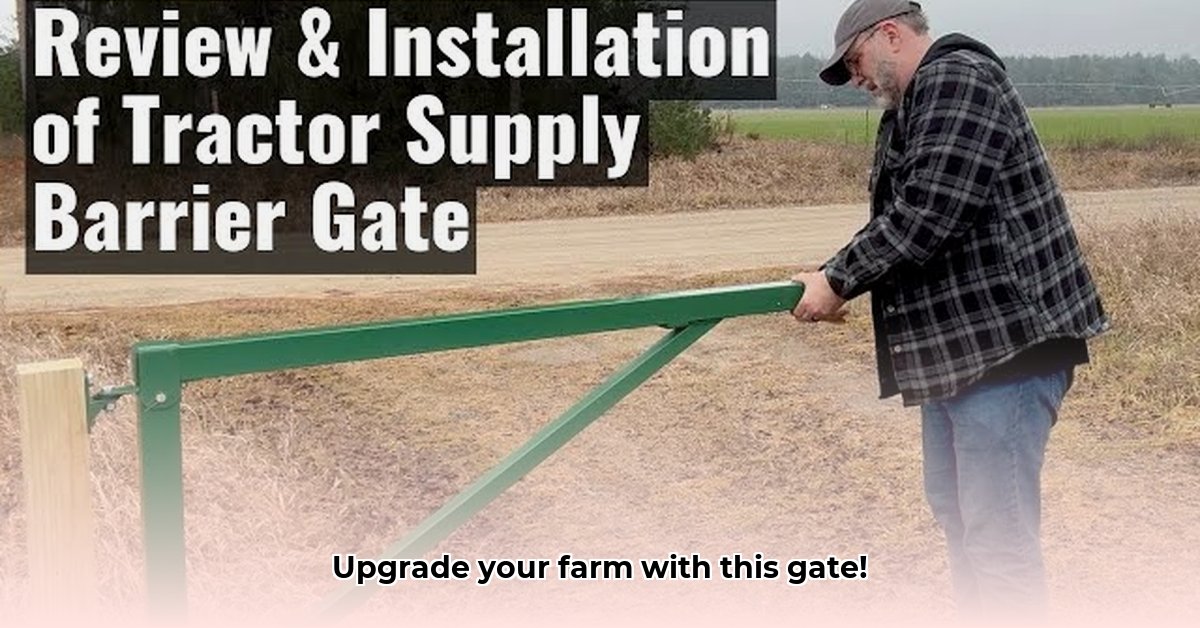
Tractor Supply 10 Foot Gate: Your Guide to Smarter, Greener Farming
Choosing the right gate isn't just about convenience; it's a crucial element of efficient and sustainable farming. A sturdy gate enhances livestock safety, protects crops, and streamlines daily operations. This guide explores how a Tractor Supply 10-foot gate can contribute to your sustainable farming goals. Have you considered how gate placement impacts your overall land management strategy? For more gate options, check out Tractor Supply Gates.
Planning Your Perfect Gate: Before You Head to the Store
Before purchasing, assess your needs. What livestock do you have? Are they prone to escaping? What's your terrain like? How will this gate integrate with existing fencing? Consider how a strategically placed gate can simplify pasture rotation for improved land management. Efficient grazing patterns are fundamental to sustainable agriculture, and proper fencing plays a vital role.
The Tractor Supply 10-Foot Gate: A Closer Look
The Tractor Supply 10-foot gate offers a balance of size, durability, and cost. Its 10-foot width suits various farming tasks, from accessing larger pastures to securing equipment. But is it the ideal choice for your specific sustainability objectives? Careful consideration is essential. Did you know that efficient pasture management can significantly reduce environmental impact?
Installing Your 10-Foot Gate: A Step-by-Step Guide
Installing a Tractor Supply 10-foot gate is a manageable DIY project for most farmers. Follow these steps:
Preparation: Clear the gate area, ensuring level ground and firmly planted fence posts. Thorough preparation minimizes installation challenges.
Post Alignment: Verify that posts are perfectly straight and evenly spaced to prevent sagging and ensure smooth gate operation. Precise alignment is crucial for both functionality and longevity.
Gate Attachment: Securely attach hinges to the posts using high-quality hardware. Don't compromise on hardware quality; it significantly impacts gate lifespan.
Latch Installation: Install a robust latch appropriate for your livestock. Consider options that are both secure and easy to operate.
Final Inspection: After installation, thoroughly inspect the gate's alignment and functionality. Make any necessary adjustments.
Material Matters: Sustainability in Action
While Tractor Supply doesn't always specify gate materials, long-term environmental impact is crucial. A durable gate reduces waste from frequent replacements. Ideally, opt for gates made from recycled materials or sustainably harvested wood whenever possible. This directly supports eco-conscious farming. Could selecting a different material better align with your vision of sustainable farming?
Weighing the Pros and Cons: Is This Gate Right for You?
Consider these advantages and disadvantages:
| Pros | Cons |
|---|---|
| Affordability and accessibility | Durability may vary depending on the specific gate |
| Suitable for many farm applications | Requires proper installation for optimal lifespan |
| Relatively easy installation | May need reinforcement on uneven terrain |
| Common size, simplifying future replacements | Might not be suitable for all livestock types |
Beyond the Gate: Sustainable Farming's Big Picture
Remember, a 10-foot gate is one component of a broader sustainable farming strategy. Soil health, water conservation, and biodiversity are equally important. A well-maintained fence system, including reliable gates, facilitates sustainable practices. Have you explored government grants to support sustainable infrastructure upgrades?
Long-Term Thinking: It's an Investment
Investing in high-quality fencing and gates reflects a commitment to long-term farm health. While initial costs might seem significant, a durable gate offers long-term efficiency and reduces replacement expenses. Explore grants or funding opportunities to offset upfront investment costs. Careful planning contributes to environmentally responsible and economically viable agriculture.
How to Choose Sustainable Farm Gates for Improved Pasture Management
Key Takeaways:
- Gate selection impacts operational efficiency and environmental sustainability.
- Durable gates minimize replacements, reducing waste and carbon emissions.
- Cost-effectiveness balances initial investment and long-term savings.
- Consider the gate's environmental impact throughout its lifecycle.
Planning Your Sustainable Gate System
Thorough planning is crucial. What are your specific livestock needs? What's the terrain like? Strategic gate placement supports efficient animal movement and rotational grazing – key elements of sustainable pasture management. Careful measurements ensure the right gate size for your needs, considering both livestock and machinery access.
Choosing Sustainable Materials
Material selection significantly impacts sustainability. Consider:
- Steel: Durable but requires considering its production footprint. Recycled steel reduces this impact. Regular maintenance is essential.
- Wood: Renewable if sustainably harvested, but susceptible to rot and insect damage. Pressure-treated wood offers longevity but contains chemicals. Explore naturally rot-resistant options.
- Composite Materials: Combine durability and sustainability, often using recycled materials. However, long-term durability and recyclability require further research.
The best choice depends on your budget, climate, and priorities.
Installation: A Step-by-Step Guide
Proper installation is critical for gate longevity and safety:
- Post Preparation: Set sturdy, plumb posts deeply in concrete, adjusted for soil type and gate weight.
- Hinge Attachment: Securely attach hinges to both gate and posts using high-quality hardware to prevent rust.
- Latch Installation: Choose a durable, reliable, and secure latch easy for you but difficult for your animals to open.
- Final Check: Thoroughly inspect the gate's alignment, functionality, and security, addressing any issues.
Maintaining Your Sustainable Gate
Regular maintenance extends the gate's lifespan, reducing environmental impact and saving money:
- Regular Inspection: Check for loose hinges, damaged wood, or rust. Address issues promptly.
- Cleaning and Lubrication: Keep hinges and latches clean and lubricated to prevent rust and ensure smooth operation.
- Prompt Repairs: Minor repairs are cheaper and more sustainable than complete replacements.
The Tractor Supply 10-Foot Gate: A Case Study (Hypothetical)
Consider a scenario using a Tractor Supply 10-foot gate for a smaller pasture with manageable livestock. Recycled steel would be a sustainable choice. Proper installation and maintenance maximize its lifespan, making it an environmentally responsible investment. However, larger pastures or heavier livestock might require a more robust gate. The 10-foot gate may prove insufficient. Further research is needed to verify material composition and lifecycle assessment of this specific product.